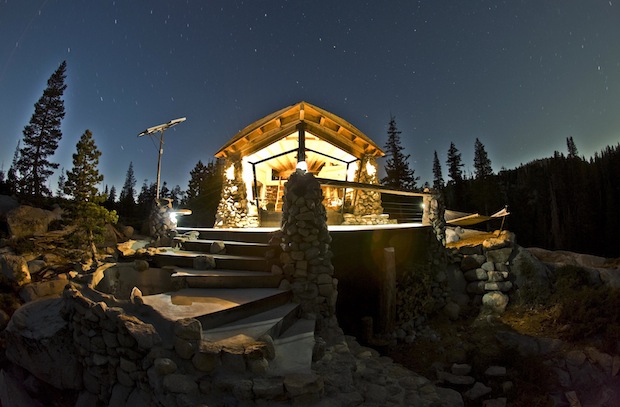 The incredible tiny cottage of snowboarder Mike Basich. Mike Basich photo.
The incredible tiny cottage of snowboarder Mike Basich. Mike Basich photo.
"It’s the biggest thing I’ve ever done," said Mike Basich, professional snowboarder and photographer, when I asked him about the iconic self-portrait and helicopter stunt that he orchestrated in Alaska, 15 years ago. He bomb dropped 120 feet down from the metal bird to a loaded roller cushioned by six feet of fresh snow—and captured the insane leap on film via a remote-operated camera tripod. He triggered the film mid-air with his right hand. Two weeks later, in a post-adrenaline surge, Basich opened the developed photo and started shaking uncontrollably, when he saw the incredible gap between his body and the white ground.
His goal wasn’t to become a world record holder for the ‘burliest heli drop ever made by a snowboarder.’ Basich wanted to produce a surreal image that warranted a doubletake: a rider suspended in the ether sans air vessel in sight.
One-of-a-kind snowboard icon Basich has an extreme ability to perform under pressure and to pioneer his own path—no matter how nonconventional or unrealistic his ideas may seem. Such self-resolve and an affinity for accepting risk has allowed him to take free falls and land, successfully, in more ways than one.
 Pro snowboarder Mike Basich dropping close to 120 feet from a helicopter for a self-portrait in Alaska. Mike Basich photo.
Pro snowboarder Mike Basich dropping close to 120 feet from a helicopter for a self-portrait in Alaska. Mike Basich photo.
Following a childhood Sacramento, Basich passionately pursued snowboarding and turned pro in the late ‘80s. He competed in the international contest circuit, earned a fortune while he rose as a top rider, and bought a 4,000 square foot house in Utah. He soon started to feel consumed by the maintenance required of a large living space, which opposed where he actually was and wanted to spend time: on the road chasing snow and playing in the outdoors. So he sold the house and bought, built out, and lived in a Ford Sportsmobile camper van for two years.
“I went from one big thing to next small thing. I also went from competing to quitting competitions in order to be back in nature without those structured responsibilities. My one goal was to be mobile, because I loved to be in storms and I needed to have more flexibility. But being in a vehicle and not needing to go through security, I could go to Alaska whenever I needed to.”
That’s also when Basich started taking self-portraits. After a decade of being captured in front of the lens, by a second-person perspective, he wanted to explore the first-perspective of catching what he felt and saw in snowboarding. Using a remote-operated camera setup, he spent three weeks attempting that first photo. After nailing a decent one, he realized how much room existed for progress. Persistence and creative drive paid off, as photography dually became a way to recreate his snowboarding career on his own terms.
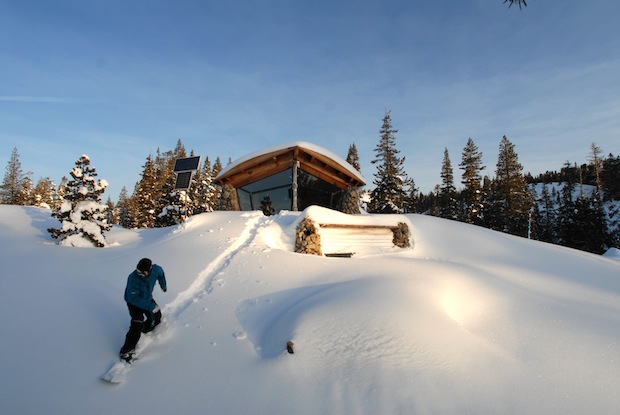 Basich snowboarding at Area-241, his property outside of Soda Springs, CA, with his hand-built cottage and ski lift. Mike Basich photo.
Basich snowboarding at Area-241, his property outside of Soda Springs, CA, with his hand-built cottage and ski lift. Mike Basich photo.
Without throwing tricks in comps, Basich soon lost his athlete sponsorships. He realized he could, instead, offer brands and publications cutting edge photography and procure revenue through the marketing and editorial budgets. His riding skill and willingness to risk his camera equipment—like jumping off of a 40 foot cliff and ending with scars on his chin—was more than compelling.
“It took about two years before people realized it was a legit thing I was doing and not just something that would come and go. I spent a lot of time getting my photos, and I started getting shots in magazines. A lot of people didn’t know what the photo caption meant: Rider Mike Basich and Photographer Mike Basich. I was going to come out with a fake name at first, because I didn’t know how to represent the idea,” Basich explained.
The Frozen Chase, published in 2015, compiles the 15-year evolution of his photography in three definitive chapters: film, digital and GoPro. In the 90s, he carried a 40-pound backpack carrying extra batteries, film and lenses, and would hike every line twice: once to set up the camera and then again to perform a trick in the frame. In a two-hour period, conditions—like a snowstorm or fog—might completely change the outcome of the photo.
“It was fun to go through photos and remember how much hard work went into it. Between running out of film and the lens fogging up, half of the photos I took didn’t turn out. I’d plan out the settings what the slide was going to look like, and if it started snowing everything changed. Having a GoPro now—something that’s not heavier than a watch—has been an amazing progression,” he said.
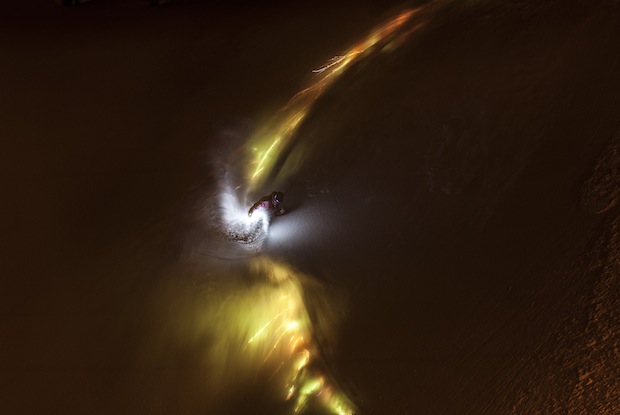 Basich snowboarding with fireworks for an artistic self-portrait. Mike Basich photo.
Basich snowboarding with fireworks for an artistic self-portrait. Mike Basich photo.
Ten years after the groundbreaking helicopter shot, Basich took another one of his favorite photos: he was snowboarding down a hillside at night, below his hand-built home, and painting a light stream with fireworks.
“I like working with and painting a picture with the art of light,” said Basich. “I rode with fireworks attached to me, which required multiple sources of lighting and timing a long exposure over a period of 12 seconds. I had to make sure the fireworks were not overexposed while also capturing the peak movement.”
Basich’s sportsmobile was the first in a succession of creative mobile living spaces. He built a 13.5-foot tall tiny home on a trailer, in December 2013, hauled by his Dodge truck. The newest rig—as of two months ago—is a built out 2012 Fuso 4WD truck. “This is a compact version of all the things I’ve built for vehicles, as far as the perfect dream rig. I searched for 1.5 months, and I got this one up in Seattle, on Craigslist.” Unique to North America, Fusos are much more common in Japan. Basich first learned about the vehicle from his mom, who is a big fan of Unimog trucks.
Basich's documentary film showcasing the construction of his newest home-rig. Mike Basich video.
Last October, Basich received an invitation from the SIA Snow Show (the annual snow sports industry trade show) to bring his tiny house to this year’s new community ‘tiny home’ village on the show floor. The organizers didn’t know he’d sold it—but he was about to build the Fuso. They gave him a 35-day deadline to finish the project and have it on location at the Colorado Convention Center in Denver, CO. Basich works best under pressure: 16 hour days for four weeks straight and he finished what might be the raddest rig he’s built, yet.
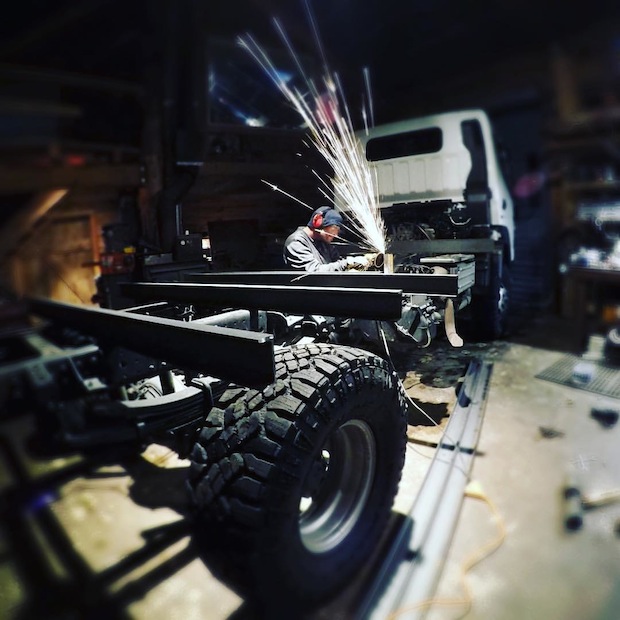 Basich building out his newest rig for living on the road. Mike Basich photo.
Basich building out his newest rig for living on the road. Mike Basich photo.
The Fuso has a trap door on the floor, for a bathtub. One side folds down into a wide-open deck, so you can soak and enjoy views of the beach or creek that’s filling your bath. The space is heated with a wood fireplace and furnace combo.
A snowmobile fits inside, which helps to shave down travel costs during ferry rides—like, $4k to $1k—in Alaska. More compact than a tiny home trailer means it’s easier to park in the city and turn around in a snowmobile parking lot. And while driving from Denver to Jackson, Basich found it champions 80 mph side winds in blizzard conditions.
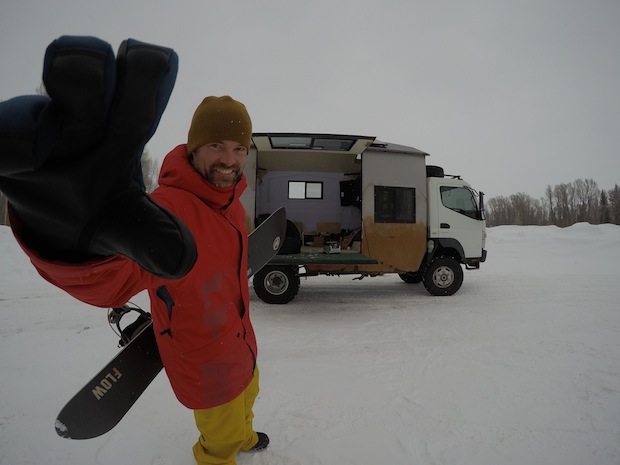 Basich putting his first miles on the Fuso home-on-wheels. Mike Basich photo.
Basich putting his first miles on the Fuso home-on-wheels. Mike Basich photo.
When the wheels aren’t in motion, Basich lives on his 40-acre haven. He finished building his dream home—an off-the-grid 225-square-foot cabin—seven years ago, outside of Soda Springs, CA. The cozy home hugs national forest on a 7,100-foot granite perch with stunning views of the Sierras. In the winter, the road isn’t plowed, so he drives a snowmobile.
“I can see the storm coming up the valley. It’s a way of watching Mother Earth’s work in the heart of the storm. This is the tallest part of the Donner Pass mountain range and you get captured up here. It’s not easy, but I love being in storms, because it’s snow powerful and quiet,” said Basich.
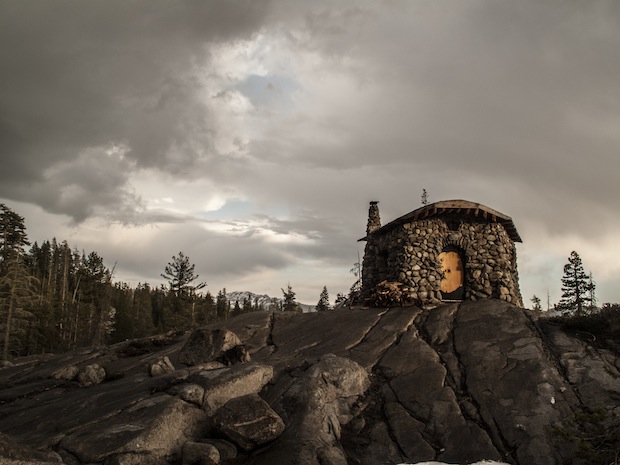 Basich's cottage on his property outside of Soda Springs, CA. Mike Basich photo.
Basich's cottage on his property outside of Soda Springs, CA. Mike Basich photo.
There’s no interior plumbing, and an outside compostable toilet. The shower doubles as a rock seat that drains through the floor. Solar panels provide the electricity and south facing windows help draw heat. The water comes directly from the creek. A chairlift on the hill lets him rip powder lap after lap.
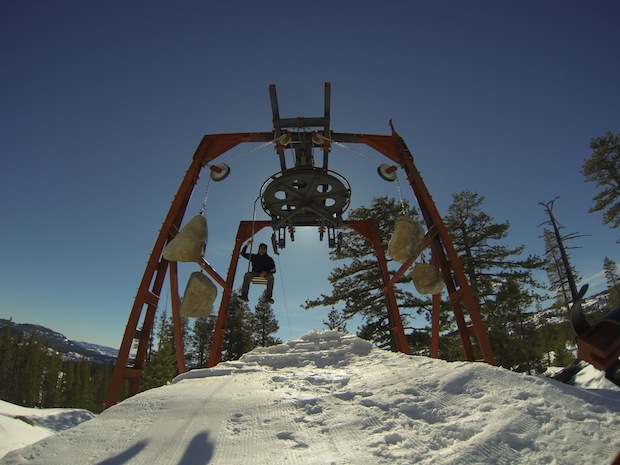 Basich's chairlift on his property. Mike Basich photo.
Basich's chairlift on his property. Mike Basich photo.
“I wasn’t sure I actually wanted it, but I’d always wanted to be forced to learn how to survive on my own and to work harder to have a connection and appreciate for staying warm. And to do this build at such a price range (because I had no power and you can’t drive in the winter)—I couldn’t say no,” he said.
 The rope tow on Basich's property. Mike Basich photo.
The rope tow on Basich's property. Mike Basich photo.
“It was a perfect combination of bringing the snow I had been chasing for 20 years to my front door instead of trying to travel the world to find it, while being close to town,” said Basich. He’s three miles from a paved road, five miles from a small grocery store, and 15 minutes from meeting friends in Truckee.
 The snow-cat on Basich's property. Mike Basich photo.
The snow-cat on Basich's property. Mike Basich photo.
Before the 5-year build period, Basich lived on the property in a teepee for a year, so he could study how the weather patterns would affect the architecture—like adding curvature to the design, inspired by a tree well, so that he wouldn’t have to shovel as much snow. (For the record, when we hopped on the phone for this interview, he’d just finished four hours shoveling his snow cat out, which was totally buried.)
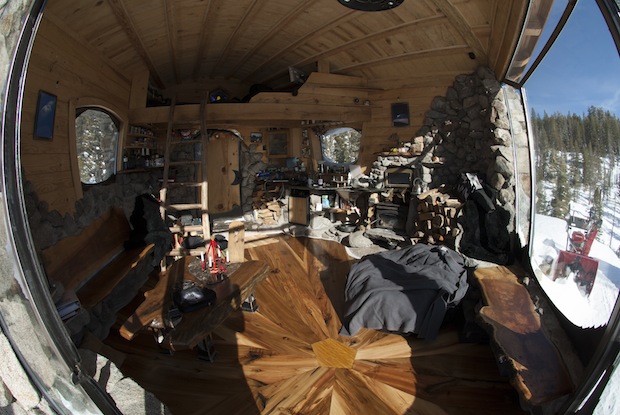 A sneak peak inside Basich's cottage. Mike Basich photo.
A sneak peak inside Basich's cottage. Mike Basich photo.
The shape of the space actually revolves around the law of nature—the golden ratio, which adds the last two numbers to receive the next number (1+1=2, 1+2=3, etc.)—to make it as comfortable as possible to live in.
 Starry night on Basich's property. Mike Basich photo.
Starry night on Basich's property. Mike Basich photo.
Now, according to his most recent update, Basich is bringing his outdoor adventure and lifestyle apparel line, 241—which he founded in 1991, and sells in Japan—to the U.S. Otherwise, keep your eyes peeled for a helicopter—or hell, an air balloon drop!
No one can predict what Basich will build or where he will land, next.




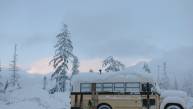

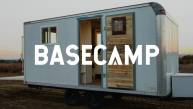


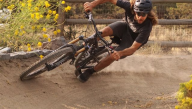

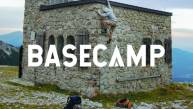
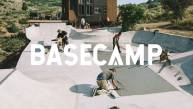
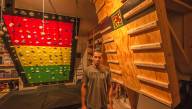


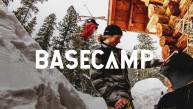
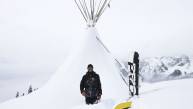
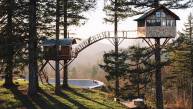
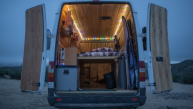
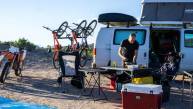
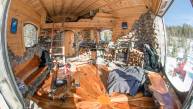
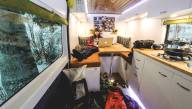
mmmm...pow!
March 7th, 2017
Legend. Stoked like a little kid for each of his projects, 100% living his dream.